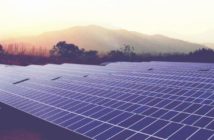Energy Central
 Sep 10, 2012 — Moroccan American Center for Policy/All Africa Global Media
Sep 10, 2012 — Moroccan American Center for Policy/All Africa Global Media
African Development Bank Group – Over the first half of 2012, the African Development Bank (AfDB) has been demonstrating its commitment to support the scaling up of renewable energy in Africa with the approval of US $800 million in loans to spur private investment in Morocco’s growing wind and solar markets.
The Bank’s technical and financial support of Morocco’s plan to develop a concentrated solar power (CSP) plant at Ouarzazate and its Integrated Wind/Hydro and Rural Electrification Program is helping Morocco realize its goal of increasing installed renewable energy capacity to 42 per cent by 2020 and becoming a renewable energy industry leader.
“Morocco has emerged as an early leader in developing low carbon, sustainable energy on a large scale, and we are proud to support their drive. Lessons learned from these projects will inform efforts going forward in the country, region and around the world,” stated Hela Cheikhrouhou, Director of the AfDB’s Energy, Environment and Climate Change Department.
Banking on the sun
In May 2012, the AfDB approved a loan for EUR168 million from its own resources and a concessionary loan for US $100 million from the Clean Technology Fund (CTF), a Climate Investment Funds (CIF) program, to finance the first phase of the CSP plant at Ouarzazate. It aims to generate 120 to 160 MW in its first phase and 500MW at full capacity, making it the largest CSP plant in the world. The project is structured as a public private partnership (PPP) between the Moroccan Solar Energy Agency (MASEN) and a private partner. Estimated at EUR1.04 billion total cost, the project will be jointly financed by six other agencies including the World Bank, European Investment Bank, Agence Francaise de developpement, German Development Bank (KfW), Neighbourhood Investment Facility (European Commission), as well as other Moroccan institutions.
Ouarzazate is the first project to be implemented under the ambitious CSP scale up program of the Middle East North Africa (MENA) region, which seeks to deploy about 1 GW of generation capacity through a series of CSP plants and associated transmission infrastructure stretching across Morocco, Algeria, Tunisia, Egypt and Jordan. Domestic energy access, economic growth and regional integration are the goals along with eventual exports to Europe.
Investing in the wind
One month later, in June 2012, the Bank made its largest project approval to date for 2012 with a loan for EUR359 million from its own resources and US $125 million from the CTF for Morocco’s Integrated Wind/Hydro and Rural Electrification Program. It aims to increase national wind power capacity by 1,070 MW and expand rural electrification to 79,436 households in 24 of Morocco’s most isolated and vulnerable districts. It is being implemented by Morocco’s public utility, Office National de l’Electricite (ONE), for a total project cost of US $2.16 billion.
The wind/hydro component of the project is designed to maximize production from wind, use excess wind energy to store water for the later production of hydroelectricity, and supply water to generate hydroelectricity during the dry season. The project will also support new transmission infrastructure and water storage facilities. Completion is envisioned for 2017.
Making renewables viable
While these projects’ potential is real, so are the high capital costs of CSP and wind technologies. Even after adjusting for fuel and operating and maintenance costs, a conventional supercritical coal-fired power plant still costs less and poses less commercial and performance risks and cost uncertainties.
The International Energy Agency emphasizes that “it is only through technology learning as a result of marketplace deployment that these costs are reduced and the product adapted to the market.” Concessional financing will help bring down these extra costs and establish cost and performance benchmarks for the broader deployment of the technologies by public and private providers in Morocco and throughout the MENA region.
“If a project is eligible for concessional finance, be it grants or loans, it indicates political support. That brings everyone on board and makes everyone more confident that the project will advance,” said Richard Claudet of the AfDB’s Private Sector Department during a lesson-sharing workshop for the MENA CSP scale up initiative co-organized by the AfDB and the World Bank on June 28.
Mrs. Cheikhrouhou added, “Financing like the Clean Technology Fund, which has a significant component that is grant-like, brings the economics and financial viability of projects closer to reality so implementation is feasible and government subsidies are less needed.”
Without AfDB and CTF funding, ONE’s financial capacity to launch the wind program would be significantly compromised and the program could be delayed or its scope reduced. ONE’s financial equilibrium would be made vulnerable by the higher cost of wind generation and the associated infrastructure, compared with the average cost of energy generated by ONE using conventional sources.
Structuring the Ouarzazate CSP plant as an independent power producer (IPP) is also beneficial from a cost perspective. A range of private and public financing can be considered and plant construction and operation can be further optimized by return considerations. However, an IPP requires robust, reliable contracts, in particular the power purchase agreement (PPA).
Morocco’s stable political and regulatory environment, as well as ongoing experience with IPPs, go a long way to inspire investor confidence.
Morocco’s wind and solar initiatives are concrete examples of green growth opportunities in Africa. Speaking at the UN Conference on Sustainable Development (Rio+20), Mrs. Cheikhrouhou explained, “Green growth is about finding the pathway where you achieve your ambitions in terms of social and economic development, but doing it in a way that is environmentally friendly; not only to be a global agent, but also to leave for future generations economies that are more robust and more able to produce jobs and resist climatic risks and disasters.”






